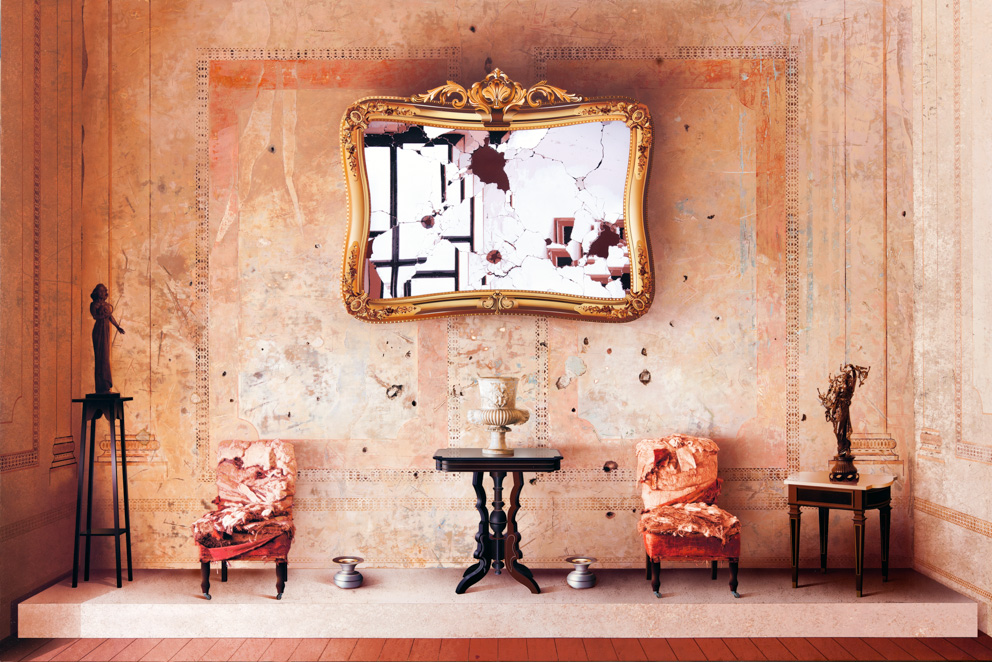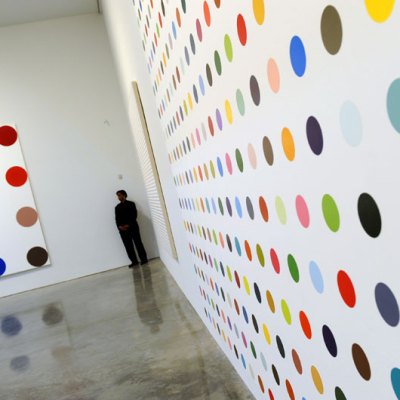Artist Ben Johnson makes time stop. His half real, half imagined, geometrically precise architectural interior paintings are distinguished by a flat, even light and perfect symmetry that draws the viewer into a reconstructed version of reality.
In his current exhibition, ‘Time Past Time Present’ at the Alan Cristea Gallery on Cork Street, instead of pristine modernist interiors, Johnson has painted five large-scale canvases of rooms that bear the scars of violence. Walls are pocked with bullet holes, upholstery savaged by gunfire, and genteel neoclassical interiors tarnished by peeling paint.
Three of the canvases are taken from his Museum Rooms series (2011–13) documenting David Chipperfield and Julian Harrap’s restoration of the Neues Museum in Berlin that was badly damaged by the Allies in the Second World War. Room of the Niobids II (2013) shows the interior of a lower gallery after restoration. Across the centre of the 19th-century neoclassical interior are Sophocles’ words, in bright gold German lettering: ‘There are many terrible things. But nothing is more terrible than man.’ With shrapnel marks still visible, the room is caught in a limbo of German imperialist histories, the words taking on new meanings and associations.
I wonder why Johnson has decided to focus on violence and the passage of time in these later works. ‘Maybe I am just coming to terms with the reality of life’, he says. ‘We cannot be in control of our past or how others choose to live or interact, all we can do is observe and learn, then do what seems right for ourselves.’
Violence is juxtaposed with stillness, past histories with present realities in Johnson’s Room of the Revolutionary (2014), which depicts the scene of a Mexican revolutionary’s assassination, now the Museo Regional de la Revolucion, Puebla. In it, a domestic interior is smashed, destroyed, and ripped apart by bullet holes. A mirror in the center is splintered, reflecting the light erratically, two chairs have stuffing exploding from ripped upholstery, and the wall is pitted with bullet holes.
‘I was moved to reconstruct this space as part of my preoccupation with the influence of the past on our present state and the power of history in guiding us to form our own values,’ says Johnson. ‘Behind every façade lies another layer or story, and all actions leave behind an energy that we as spectators can choose to contemplate or ignore.’
Approaching the Mirador (2013), which shows an ideal, amalgamated view of the Alhambra in Granada, is one painting in the exhibition that doesn’t depict a space of obviously violent history. The intricate, geometric shapes of Islamic religious decorations are precisely reproduced, forming a kind of meditative imitation of reality. Why, in instances like this, does Johnson still use painting in an age of photographic reproduction?
‘Photography is a powerful tool, as is 3D modeling, as they can both produce illustrations of architectural interiors. I have no interest in illustration, however…For me, architecture is a vehicle for exploring material to create a painting, and through raw materials create an emotional response. It is what lies within a space that interests me, and my job is to expose that underlying energy.’
‘Ben Johnson: Time Past Time Present’ is at the Alan Cristea Gallery, London, until 7 June.






